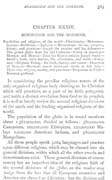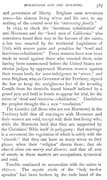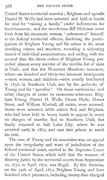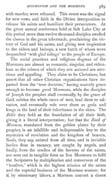
[p. 563]
CHAPTER XXXIV.
MORMONISM AND THE MORMON'S.
Population and religions of the world—Christianity—Mohammedanism—Buddhism—Judaism—Mormonism: its rise, progress, history, and practices—Joseph the prophet and his followers—The golden plates from the hill Cumorah—Christ in America—Mormon and Moroni—John the Baptist ordains Joseph Smith—Smith's birth, early history, life, adventures, and death—Polygamy—Brigham Young: his birth, history, and career—Desertion of Kauvoo—Mormons march westward—Settle at Salt lake—Their city, religion, society, and practices—Despotism in Utah—Mormon godhead.

[p. 587]
Trouble continued to accumulate with the saints in 1870-1. The mystic circle of the "holy twelve apostles" had been broken by the rude hand of the

[p. 588]
United States territorial marshal; Brigham and apostle Daniel H. Wells had been arrested and held in bonds for trial for "raising a family," under indictments for lasciviousness; and the murderous Bill Hickman came forth from his mountain retreat, "unbosomed" himself to the federal territorial officers, disclosing the participation of Brigham Young and his saints in the most revolting crimes and murders, revealing a sickening record of individual assassinations, and ending with the avowal that the direct orders of Brigham Young preceded almost every murder of the terrible list of slain in Utah; and that the Mountain Meadows massacre, where one hundred and thirty-two innocent immigrants—men, women, and children—were cruelly butchered in 1858, in Southern Utah, was by the authority of Young and his "apostles." On these confessions, and other charges of crime by numerous witnesses, Brigham Young, Daniel H. Wells, Orson Hyde, Hosea Stout, and William Kimball, all saints, were accused. Some were arrested, while others fled, and Brigham, who had been held in heavy bonds to appear in court on charges of murder, fled to Southern Utah, but finally returned to Salt Lake City, where he was arrested early in 1872, and cast into prison to await his trial.
The case of Young and his associates was, on appeal upon the irregularity and want of jurisdiction of the federal territorial court, carried to the Supreme Court of the United States, which held that the manner of drawing juries by the territorial courts from September 20, 1870, to April, 1872, was illegal. By this decision, on the 25th of April, 1872, Brigham Young and four hundred other prisoners, including twenty-four charged

[p. 589]
with murder, were released. This event was the signal for new vows, and faith in the Divine interposition to release his saints and humiliate their persecutors. At the great annual conference held at Salt Lake City at this period more than twelve thousand disciples swelled the chorus in the great tabernacle, proclaiming the victory of God and his saints, and giving new inspiration to the elders and bishops, a new batch of whom were despatched "with glad tidings" to the people of Europe.